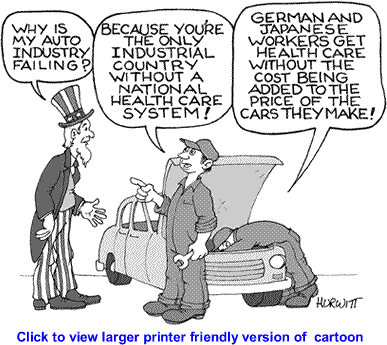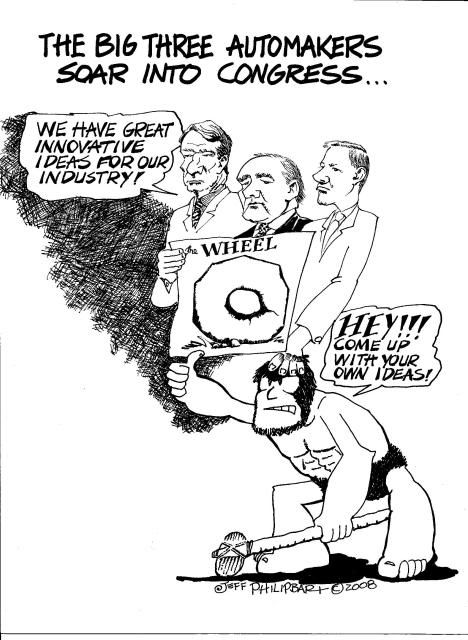By Kristin Makszin
The different perspectives on whether or not to bailout the U.S. auto industry vary according to the alleged cause of the ‘crisis’ for the auto industry. Was this crisis caused by recent economic events (i.e. financial crisis, fall in consumption), bad decisions by the big three company leadership over time (producing SUVs, not fuel efficient automobiles), burdens of health and pension commitments to retired auto workers (a result of organized labor), political decisions, unstable oil prices, …?
Obviously there are multiple reasons why the auto companies are in the situation that they are currently in. But the problems in the U.S. auto industry are not new. Arguably, the current challenges are a continuation of a thirty year story – or perhaps an even longer one. The many events on this thirty year time line suggest that the U.S. auto industry is fragile. Which raises the question: can it be saved? And what would it take to save it?
Analysis of the current situation of the U.S. auto industry emphasizes the importance of the political and economic institutions that form the context in which businesses are embedded. Auto production began to move away from Detroit (to other countries and even other parts of the USA)—many argue—because of the high level of organization of auto workers in Detroit. But the decline of the auto industry in Detroit was also assisted by shifts in the global economy that allowed car production to increase in other parts of the world (the U.S.A. lost its comparative advantage in car production). Further the big three auto producers (GM, Chrysler, Ford) fell behind in the newest and most important innovation: greener cars. The reason that the U.S. auto industries fell behind in the ‘greening’ process could be blamed on the decisions of company executives, the American consumer, U.S. foreign policy, … But it is clear that NOW is time for the auto industry to innovate and the big three are already behind. According to the Varieties of Capitalism (VoC) framework, the U.S. economy relies on complementarities between deregulated labor markets, innovative product markets, competitive relationships between firms, a financial system where firms raise money from equity markets, and an educational system promoting general skills. The auto industry seems to be the exception to the liberal market economy framework. The strength of labor is impossible to ignore, thanks to the United Auto Workers. It would be hard to describe anything that happened in Detroit in the last 30 years as a part of innovative product markets. The big three have formed a ‘cooperative’ relationship in begging for the bailout. From a Varieties of Capitalism perspective, it does not seem surprising that the U.S. auto industry could not survive without the complementary institutions. Now that the equity-based financing is not sufficient and the executives of the big three (and many others in Detroit) argue that government funding should be used to keep these business alive-- because they are "too big" to fail.
According to the Varieties of Capitalism (VoC) framework, the U.S. economy relies on complementarities between deregulated labor markets, innovative product markets, competitive relationships between firms, a financial system where firms raise money from equity markets, and an educational system promoting general skills. The auto industry seems to be the exception to the liberal market economy framework. The strength of labor is impossible to ignore, thanks to the United Auto Workers. It would be hard to describe anything that happened in Detroit in the last 30 years as a part of innovative product markets. The big three have formed a ‘cooperative’ relationship in begging for the bailout. From a Varieties of Capitalism perspective, it does not seem surprising that the U.S. auto industry could not survive without the complementary institutions. Now that the equity-based financing is not sufficient and the executives of the big three (and many others in Detroit) argue that government funding should be used to keep these business alive-- because they are "too big" to fail.
Some Republican Senators (among others) have suggested that part of the bail out should demand pay cuts from the United Auto Workers and that innovation should be forced towards a more environmentally friendly car. Interestingly, the Republican Senators are addressing two other dimensions of the auto industry that seem to be mismatched with the liberal market economy capitalism that is predominate in the USA. But, from the lens of the varieties of capitalism framework, it is clear that the bailout package (even with all potential additional stipulations) would be incapable of making the auto industry work in the absence of complementary institutions. So perhaps it is time for Schumpeterian ‘creative destruction’ in Detroit.
From the streets of Detroit, the need for a bailout for the auto industry is clear. Too many lives and companies depend on it. If the big three are allowed to go bankrupt, Detroit will suffer and there will likely be strong ripple effects. But it seems clear at this point, a short term bailout is not enough. Drastic changes will be needed if the auto industry will survive in Detroit. If the big three stand a chance, they must use the advantages of their (supposed) institutional context to be the leaders in innovation towards greener cars. But it might already be too late. The only thing that seems certain for Detroit is that everything will change. Either the big three automakers will face real reform or they will continue their slow descent until U.S. auto production is only a memory.
The effects of this for Detroit are clear. But what will this mean for automakers in Europe and Asia?
Dec 18, 2008
What does Varieties of Capitalism have to say about the bailout of the U.S. auto industry?
Subscribe to:
Post Comments (Atom)




3 comments:
Kristin, reading this blog, makes me think of the Documentary "Who killed the electric car" Very insightful into the role of the three big dynosaurs and their reluctance to learn new tricks...
http://en.wikipedia.org/wiki/Who_Killed_the_Electric_Car%3F
There truly are a variety of issues that have either crept up on or have come suddenly to the US automakers. What has crept up on them is the following: health care costs for current employees and retirees; the aging and longer lifespan population with now 3 retired GM workers for every active whose pention and health care are all paid by GM (US Social Security and Medicare starts at age 65 - 70 defraying some costs); the large number of dealers inplace (4500 whose contracts are protected by state law). WHat has come to them suddenly is the cost of fuel; in both directions. When fuel hit $4.30US per gallon this summer, everyone wanted small fuel efficient cars, now that it is back to $1.60US I wonder what consumer will want now? Perhaps we should adapt the approach of other countries and apply significant taxes to fuel and to large vehicles/engines to deter their use. The economic lever is the only viable one. Not many people will "do the right thing for the environment" and spend an extra $10K for the vehicle to do so.
For Andray's information, the first modern day production electric vehicle was produced by GM, the EV1. With the then low cost of fuel and high production cost (battery) without subsidies, no one wanted one. They went out of production after two years.
hi, i am doing a paper on VOC in asia. i must say that your paper addressed a central concern that i have and thats is VOC is not too unwieldy a framework when it comes to examining PE outcomes in countries. there's js not enuf varieties..
Post a Comment